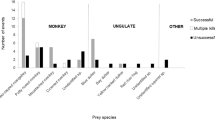Abstract
Data on patterns of systematic and ocassional hunting of birds, mammals, reptiles, mollusks and insects by Stumptail macaques are reported for a period of ten months. Systematic hunting of water snails, terrestrial spiders, and land worms was conducted by all age classes, except infants, and both sexes. Of the occasional hunting of birds, large lizards, large frogs, and field mice, the adult females conducted 70%, the adult males 12%, the two year old females 12%, and the two year old males 6%. The differences between males and females were statistically significant (.05 confidence level). Females dominated the hunt and were more interested in meateating than the males. This contrasts strikingly with the data reported for baboons and chimpanzees in which the males dominate the hunt.
Of all the prey hunted ocassionally, 76% was shared. The differences between shared and not sared prey were statistically significant (.05 confidence level). All age classes, including infants, participated in meat-sharing. Three types of meat-sharing are described: mother-offspring, hunter-close-friend, and piece-dropping. The prey was shared with genetic relatives, and with close and sistant friends in this order. Pearson’s correlation coeficients between rank of hunter and number of hunts and between rank of hunter and number of individuals with whom the prey was shared yielded +.866 and +.890 respectively. Meat-sharing seems to be similar to that observed for baboons but some differences exist between baboons and chimpanzees on the one hand and Stumptails on the other. Dominance relations in our Stumptails seem to act as the context determining the direction and the type of sharing.
An increase in hunting activity during the study period is suggested to be the result of the prey’s migratory and breeding patterns, of environmental changes, and of the high activity scores and physiological states of the adult-females in the troop. Although not hunted, reactions to snakes, iguanas, scorpions, and gulls are also described.
Similar content being viewed by others
References
Coelho, A. M., 1974. Socio-bioenergetics and sexual dimorphism in primates.Primates, 15: 263–269.
Estrada, A., 1977. A ten month field study of the ontogeny of social relations in a free-ranging troop of stumptail macaque (Macaca arctoides). Ph. D. Thesis, Rutgers University.
———— &R. Estrada, 1976. Establishment of a free-ranging colony of stumptail macaques (Macaca arctoides): Relation to the ecology, I.Primates, 17: 337–355.
————, ————, &F. Ervin, 1977. Establishment of a free-ranging colony of stumptail macaque (Macaca arctoides): Social relations, I.Primates, 18: 647–676.
Van Lawick Goodall, J., 1968. The Behaviour of free-living chimpanzees in the Gombe Stream Reserve.Anim. Behav. Monogr., 1: 161–311.
Harding, R. S. D., 1973. Predation by a troop of olive baboons (Papio anubis).Am. J. Phys. Anthrop., 38: 587–592.
Hamilton, W. D., 1964. The genetical evolution of social behaviour, I.J. Theoret. Biol., 7: 1–16.
Rhine, R. J., 1973. Variation and consistency in the social behaviour of two groups of stumptail macaques (Macaca arctoides).Primates, 14: 21–35.
Strum, S., 1975. Primate predation: Interim report on the development of a tradition in a troop of olive baboons.Science, 187: 755–757.
Teleki, G., 1973.The Predatory Behaviour of Wild Chimpanzees. Bucknell University Press, Lewisburg, Pa.
Trivers, R. L., 1971. The evolution of reciprocal altruism.Quart. Rev. Biol., 45: 35–57.
Welkowitz, J., R. B. Ewen, &J. Cohen, 1971.Introductory Statistics for the Behavioral Sciences. Academic Press, N. Y.
Author information
Authors and Affiliations
Additional information
This work was supported by grants from Behavioral Sciences Foundation and by NSF Grant No. GB-42235.
About this article
Cite this article
Estrada, A., Estrada, R. Patterns of predation in a free-ranging troop of stumptail macaques (Macaca arctoides): Relations to the ecology II. Primates 18, 633–646 (1977). https://doi.org/10.1007/BF02383140
Received:
Accepted:
Issue Date:
DOI: https://doi.org/10.1007/BF02383140




